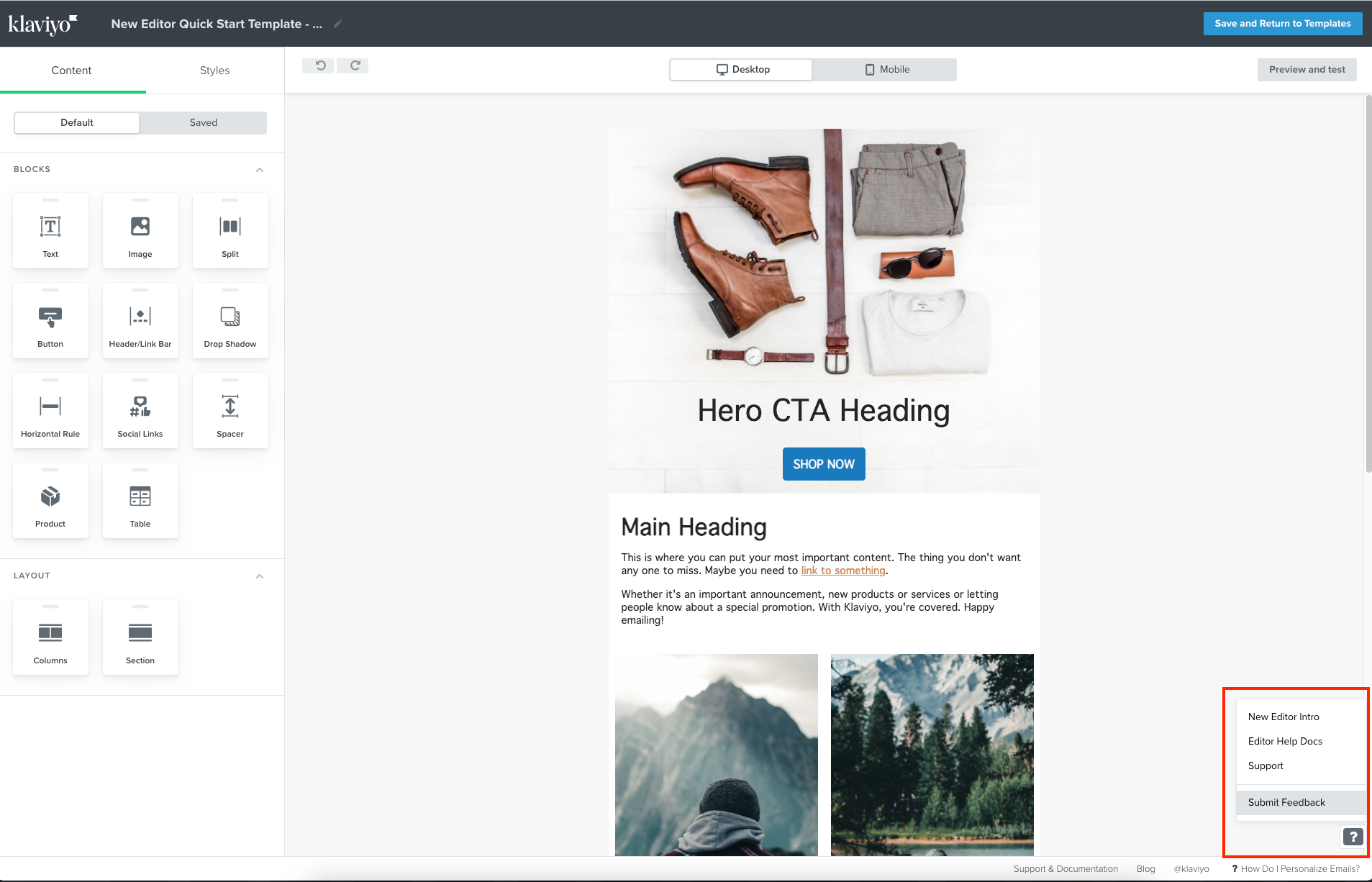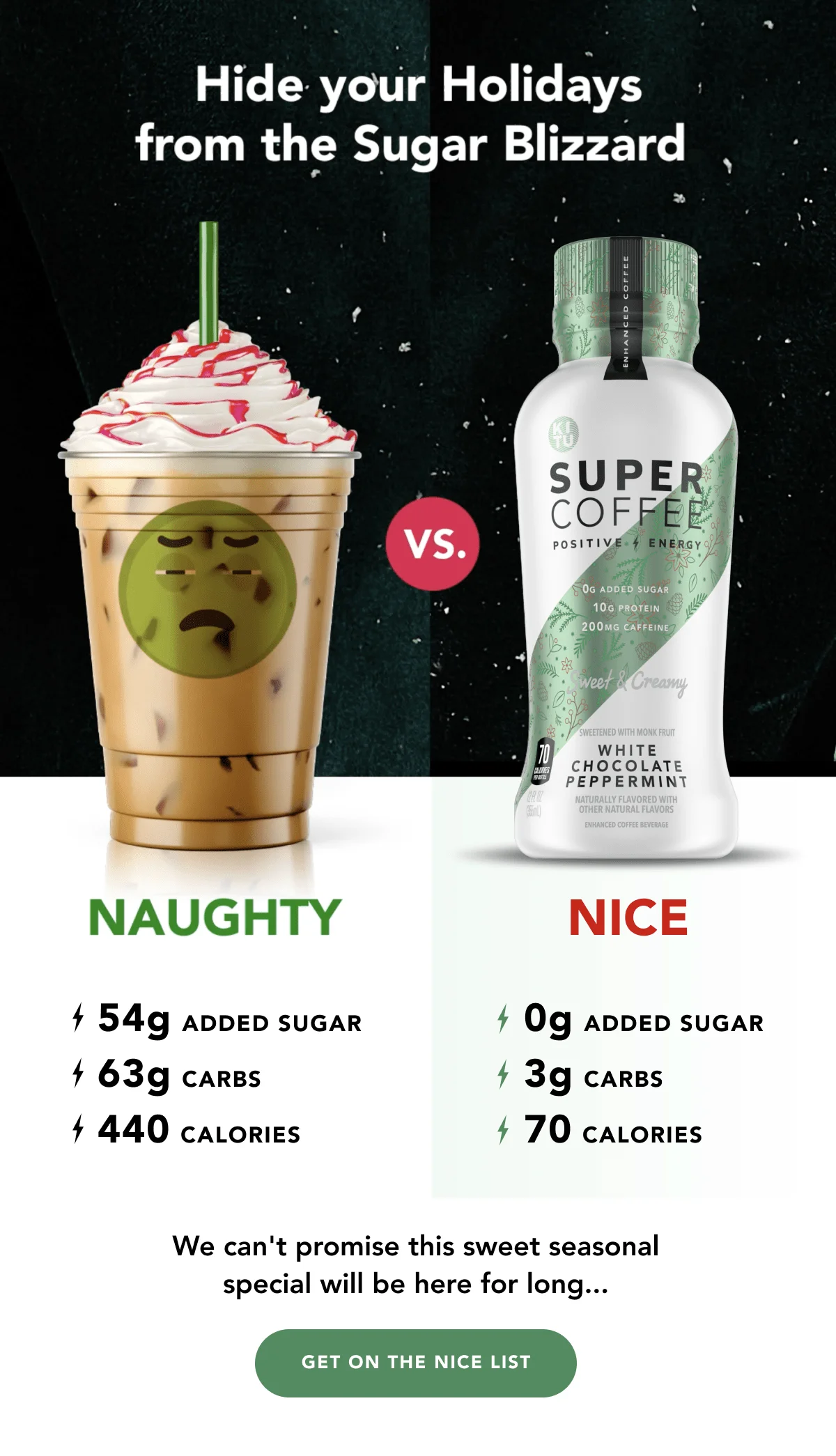How To Use Klaviyo Campaigns
If you’re just getting started with email marketing or new to Klaviyo, it’s important to get out of the mindset of just sending out email campaigns during promotions or product launches. As an e-commerce brand, you should aim to generate 15-20%...
Tags
Tools
Level
Related Partners

If you’re just getting started with email marketing or new to Klaviyo, it’s important to get out of the mindset of just sending out email campaigns during promotions or product launches. As an e-commerce brand, you should aim to generate 15-20% of your business revenue from email campaigns.
A great email campaign strategy involves creating an effective email marketing calendar, sending campaigns regularly (1-3x per week), and sharing unique email content to build a relationship with customers.
Why Klaviyo Campaigns?
Campaigns are one-time, targeted emails that are sent to your email list. Mastering Klaviyo campaigns is the first step to learning how to use Klaviyo for email marketing.
Klaviyo’s drag and drop editor & pre-built email templates make it friendly for beginners. But its extensive A/B testing functionality, segmentation & dynamic content make it incredibly scalable as your business grows.
Setting Up Your Klaviyo Campaign
There are a few key elements you’ll need to decide on when setting up your Klaviyo campaigns:
- Campaign name: Choose a descriptive name for your campaign that reflects the topic of the email, the type of content it contains, and makes it easy for you to identify in your dashboards.
- Recipients: Determine the target audience for your campaign. In Klaviyo, you can choose to select specific segments or lists. Segments are groups of email subscribers based on characteristics or behavior (eg. has opened an email at least once in the last 90 days), whereas lists are typically groups of email subscribers who joined from a specific source (eg. welcome pop-up).
- Sender name: Decide on the name that will appear as the sender of your email. Most e-commerce stores use the name of their brand to make it recognizable.
- Sender address: Provide the email address your campaign is sent from. Make sure it aligns with your brand (eg. team@brandname.com) & has a healthy deliverability score.
- Reply to email address: Specify the email address where recipients can reply to your campaign. Most brands select their customer support email address (eg. support@brandname.com) to ensure responses are received and handled.
- Subject line: Write an eye-catching subject line that catches recipients’ attention in the inbox and gets them to open the email, while still being relevant to the content
- Preview text: Write a concise preview text that appears alongside the subject line and provides a teaser or hook to the content in the email.
- A/B test: Consider conducting an A/B test by creating variations of your campaign to test different subject lines, content, or visuals to optimize for more opens, clicks, and conversions.
- Send date & time: Choose the optimal date and time to send your campaign, taking into account the habits and preferences of your target audience.
Creating Your Klaviyo Email Campaigns
Drag And Drop Editor
When it comes to crafting email campaigns, Klaviyo lets you choose between three different options: plain-text, HTML, and a drag-and-drop editor. Most brands create their Klaviyo campaigns using the drag-and-drop editor since it’s easy-to-use and allows you to create visually appealing, branded, and high-converting emails.
The editor is designed to be user-friendly, allowing you to easily customize your email layout, add images and text, format content, and include dynamic elements such as product recommendations or personalized messaging.

Templates
Klaviyo also has a pre-built template library to easily create email campaigns. It includes templates for newsletters, product spotlights, promotions, content emails & product launches. You can also create your own custom templates for your brand to make it easy to go from idea to launch. To make your email campaign creation even easier, you can leverage tools like Backbone, which generates custom email layouts.

5 Types of Klaviyo Email Campaigns You Should Be Sending
These are 5 types of unique email campaigns you should be sending in Klaviyo:
Product Highlight
Showcase a specific product from your inventory, highlighting its unique features, benefits, and value proposition. This campaign can generate revenue by driving interest and purchases, particularly from customers who are interested in that particular product or have shown previous engagement with similar items.

Product Roundups For “CUSTOMERS/PAIN POINT”
Create curated product roundups tailored to specific customer segments or pain points. By addressing their needs or preferences, this campaign can generate revenue by providing personalized recommendations and making it easier for customers to discover and purchase relevant products.

“Us vs Them”
Engage your audience by highlighting the advantages and differentiating factors of your brand compared to competitors. This campaign can generate revenue by positioning your products or services as superior and encouraging customers to choose your brand over others.

Customer Stories
Share success stories or testimonials from satisfied customers who have had positive experiences with your brand. This campaign can generate revenue by building trust, social proof, and credibility, ultimately motivating potential customers to make a purchase based on the positive experiences of others.

Seasonal Guides
Create informative and visually appealing seasonal guides that provide tips, inspiration, and recommendations related to your products or industry. This campaign can generate revenue by leveraging the excitement and specific needs of each season, driving customers to explore and purchase relevant products to enhance their seasonal experiences.

Other Ways To To Grow Your Email Performance
Mastering Klaviyo email campaigns is just the start to generating more revenue from email for your e-commerce brand. Learn how to set up Klaviyo email flows and implement Klaviyo flow filters to create targeted and automated email sequences that nurture leads, engage customers, and drive conversions… automatically.
A white-glove service built for success.
We've planned every part of your client experience so you know you're in good hands.
Related Posts

How To Best Use and Understand Klaviyo Flow Filters
As a DTC e-commerce brand, email marketing is one of the most powerful channels to nurture, convert, and retain your customers. But as you grow, customer segmentation becomes an increasingly more important strategy to drive more revenue, higher engagement and more conversions.Enter Klaviyo flow filters.Flow filters might seem like a small, technical feature in learning how to execute email marketing with Klaviyo but they're one of the keys to segmenting your automated flows (along with trigger filters, trigger splits, and conditional splits). Trigger and flow filters act as gatekeepers of your email flows, to allow only the right people to receive the right messages, at the right time.In this guide, you'll learn how Klaviyo flow filters work, ways to use them, and how to set them up for your email flows.What are flow filters in Klaviyo?Flow filters are criteria or conditions you set to determine which email subscribers enter the flow. You can set flow filters based on a variety of conditions such as a customer's location, their purchasing behavior, their engagement with previous emails, or specific characteristics such as their pain points.This allows you to build more customized customer journeys for your email subscribers by having different customers receive different flows.How...

Crafting Engaging Welcome Series Emails: Examples and Templates
30 Second Summary1. 50-75% of the revenue from your Welcome Series typically comes from the first welcome email. So if you do nothing else, focus on doing that right.2. Use the subject line "Welcome to [BRAND]" or "Here's your 10% off code for [BRAND]" to start. Then A/B test.Your Welcome Series is one of the most important automated email flows you can build to set your new e-commerce brand up for success at launch. In fact, if you don't do anything else in email marketing (which we don't recommend!), build your welcome series.Now, you've likely heard that the goal of welcome emails is to introduce or indoctrinate your brand to new email subscribers.But that's not (quite) true.The real goal of a welcome series is to drive your leads to make their first purchase.Done right, a well-crafted Welcome Email Series can accelerate your customers' journey to their first purchase, drastically reducing your cost per acquisition (CPA), bolstering your average dollars per lead and per website visitor, and increasing your average order value (AOV). See why it's one of the most important automated flows you could build?Now, in your research, you've also probably seen lots of inspiration for different welcome emails, been told that "every...

From Zero to Hero: A Complete Guide to Building Your Email List
30 Second Summary1. Your email list is one of the most valuable assets an e-commerce brand can have & building your email list is the first step to effective email marketing.2. Don't make the mistake of building an email list just for the sake of it. You don't just want a list of emails, you want a list of potential customers.3. At a minimum, make sure you have a welcome opt in form, exit intent opt in form, footer signup form, and a sign up form at checkout to capture email subscribers4. Advanced strategies to collect email addresses like lead magnets, quizzes, paid ads, as well as partnerships and giveaways, are other ways to grow your email list5. Regularly clean out your email list, especially for lower-quality leads, and track key metrics such as list growth percentage, unsubscribe percentage, and engagement percentage to measure your success and optimize your email marketingIf you're just getting ready to launch your e-commerce store, or you're new to email marketing, building your email list is an important first step. Your email list is one of the most valuable assets your brand can have to nurture, convert & retain customers to grow your brand.Most e-commerce brands...
7 Best Practices For Email Design To Elevate Your Email Marketing
30 Second Summary1. Email design plays a crucial role in the success of DTC e-commerce businesses by capturing attention and compelling action.2. Visual hierarchy guides readers' attention, and scannability enhances engagement.3. Customizing the copy-to-image ratio based on industry, brand, and email type optimizes the impact.4. Strategic CTA placement and clear, compelling button copy increase click-through rates.5. Personalization goes beyond addressing recipients by name and focuses on relevance and meeting individual needs.6. Brand consistency fosters recognition and recall, creating a cohesive brand experience.If you believe that email design is merely about making your emails visually appealing, then you've missed the mark. Email design is the final step in email strategy to drive revenue & convert customers.In this blog post, we will explore the 7 email design best practices to beyond aesthetics & make your emails effective:Visual hierarchyInformation architectureCopy-to-image ratioScannabilityCall-to-action (CTA) placementPersonalizationBrand consistencyGet ready to redefine your approach to email design & master these concepts to create high-converting emails.Anatomy Of An Email: Using An Email LayoutEmail design all starts with the email layout. An email layout is the bones of your email design. Without a strong, high-converting email layout, an email can look beautiful but it won't convert. Think of it kind of like...

Don’t Let Them Get Away: Crafting the Perfect Abandoned Cart Email
With cart abandonment rates averaging around 69% for e-commerce stores, you can't afford to let potential sales slip through the cracks. Abandoned cart emails target these customers who abandon their cart to get them to return to make a purchase. Building an effective abandoned cart email can be quick & easy with the right strategy.By the End of This Blog, You'll:1. Confidently build your first abandoned cart email to convert more customers & drive more revenue2. Understand the core elements that make up an effective abandoned cart email3. Have conversion-optimized abandoned cart email templates to use4. See examples of great abandoned cart emails & subject lines for inspiration5. Have a list of A/B tests to optimize your abandoned cart email strategyOther Resources You May Find Helpful:Our DTC Flow Foundations Guide: This is your ultimate playbook for not just mastering the art of abandoned cart emails, but creating a holistic suite of email flows vital for any DTC e-commerce brand. From welcome series to customer re-engagement strategies, it's all there.Our Free Beginner's Guide To Email Marketing: Starting from scratch? No worries. Our beginner's guide provides you with the A to Z of email marketing. It is tailor-made for e-commerce brands and...

21 Email Marketing Examples to Inspire Your Next Campaign
In the competitive world of DTC e-commerce, a crucial element of customer retention is keeping customers engaged with your brand. Email marketing campaigns are a great way to stay top of mind and relevant to your customers. It's not enough just to send email marketing campaigns about your product. To drive engagement, loyalty, and sales, you need impactful, unique & relevant email campaign topics. That's where an effective email marketing campaign strategy starts.We've put together 21 email marketing examples that are more than just creative inspirations—they're powerful strategies that have driven results for DTC brands. Use these email marketing examples to inspire your next campaign.Use these email campaign examples to generate 3 new campaign ideas to test in the next 60 days!Effective Email Marketing Examples1. Save The Date EmailsSave The Date emails are perfect for creating anticipation for an upcoming promotion or new product launch. The suspense & advanced notice generates more interest, engagement & revenue on launch day. Add in a calendar invite or link to a Facebook event to easily remind interested customers on the day of launch.We tend to see Save The Date emails consistently work for most e-commerce brands, but are particularly explosive for limited edition...

Email Marketing Metrics: Unlocking the Power of Data to Drive Your Campaigns
Whether you're struggling with the intricacies of Klaviyo's built-in reporting, drowning in an ocean of dashboards, or simply seeking ways to turn your data into actionable strategies, you're in the right place. We're here to help you navigate the complexities of email marketing metrics and tap into the wealth of insights they offer.This blog post is for you if:1. You're still using Klaviyo's built-in reporting & don't know how to interpret the data.2. You have a myriad of dashboards filled with email data, but you're not sure what needs your attention.3. You're feeling overwhelmed with your email marketing data and want to focus on what's important.4. You want to turn your data into actionable strategies to enhance performance.Many DTC ecommerce brands, perhaps even yours, fall into the trap of over-investing in data accumulation and under-investing in actioning on it. This blog post is designed to help you break free from this pattern.What you'll learn in this blog post:1. The key email marketing metrics you should be measuring.2. What your email marketing metrics are telling you about your customers & the effectiveness of your strategy.3. How to interpret your email marketing data through benchmarking red/green/yellow.4. How to devise a plan of...

Email Marketing Analytics and Benchmarking: The Key to Unlocking Your Campaign’s Potential
So you've started running email marketing campaigns, but now what? Most DTC brands just collect the data & measure the performance of their email campaigns. But that's not enough.Which email marketing metrics should you look at? How do you analyze your email metrics? What do you do with that data? And how will you actually adjust your strategy to consistently improve your performance over time?It's not what data you have, but how you use the data that will scale your email marketing performance.Meet the principle of Actionable Reporting.Actionable reporting is all about transforming raw data on your email metrics into meaningful, easy-to-understand insights and applying them to actionable next steps in improving your email marketing performance. It's about identifying trends, finding patterns, and flagging opportunities to not only understand what's working but also uncover areas that need improvement.Mastering the art of Actionable Reporting is learning how to turn data into information, information into insights, and insights into strategy.Data --> Information --> Insights --> StrategyThere are 3 key elements to effective Actionable Reporting:Email Marketing Metrics: Collecting the right data is crucial to the start of this process. Email marketing analytics allows you to dive deep into the performance metrics of your campaigns, identifying what works and what...

The Ultimate Guide to Different Types of Email Marketing Campaigns
Email marketing is an incredibly important channel to master for any DTC e-commerce business. In fact, with the right approach, email marketing can contribute to a whopping 20-30% of your revenue. It's a great way to retain customers, drive conversions, increase repeat purchase rates, elevate customer lifetime value (LTV), get more customers hooked on subscription products and encourage them to splurge on higher average order values (AOV). But it can feel overwhelming with all of the different types of emails, from email campaigns to automated email flows, that you should have.=If you're new to email marketing —we've got your back with this ultimate guide to the different types of emails. By the end of this post, you'll be ready to create a solid email marketing strategy to get your e-commerce store generating $5M, $10M and even $20M+ in revenue.Get a custom-built email marketing strategy with a 14-day free trial of Backbone.Use Backbone to plan out your email marketing calendar with different types of campaigns, flows, promotions & product launches. With over 5000+ unique campaign ideas & 250+ unique flows, everything is customized for your business!Book Your DemoTypes of EmailsNow, let's dive into the most different types of emails that every...


